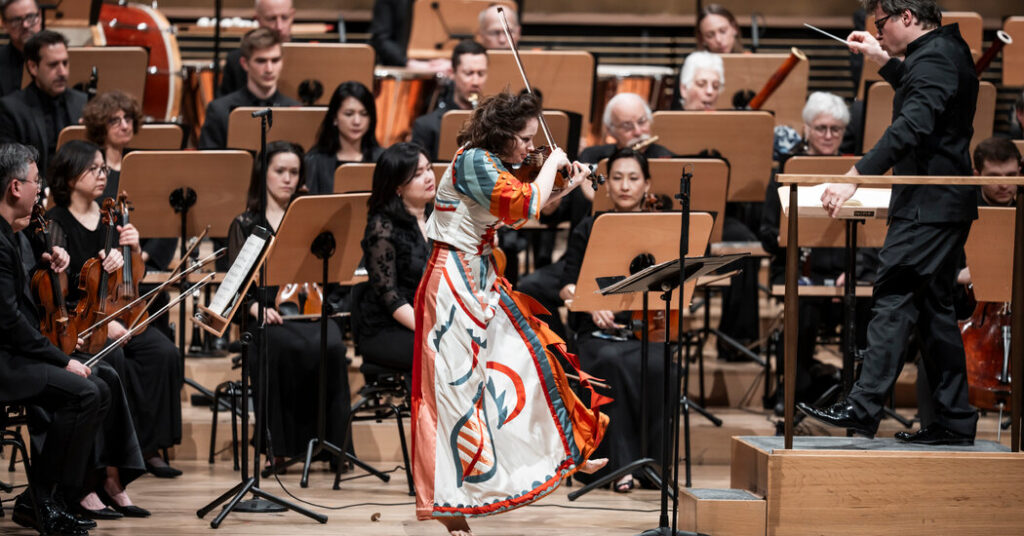To judge by its marketing materials, the New York Philharmonic is uncomfortable with its leaderless state, created by the gap between the departure last summer of the music director Jaap van Zweden and the arrival of Gustavo Dudamel, who takes over in 2026. Dudamel’s likeness is already splashed all over Lincoln Center, as if the mere promise of him were the orchestra’s best hope for selling tickets. But the parade of visiting conductors passing through Geffen Hall has had its own rewards, shaking the ensemble from its routine and injecting a vital note of unpredictability. Week by week, the orchestra sounds different. The energy in the hall fluctuates. And when a firebrand soloist joins a smoldering conductor, sparks fly.
This was the case on Wednesday in an electrifying concert that drew tumultuous ovations. The Czech conductor Jakub Hrusa teamed up with the flamboyant violinist Patricia Kopatchinskaja, who shredded the Stravinsky Violin Concerto — and more than a few bow hairs — on a program that opened with the world premiere of Jessie Montgomery’s sumptuous “Chemiluminescence” and ended with a glowing reading of the Symphony No. 1 by Brahms.
The previous week had featured another ferociously expressive soloist in another world premiere when the cellist Alisa Weilerstein performed a Thomas Larcher concerto, “Returning Into Darkness,” on a program bookended by Mendelssohn and Schumann. There, it was Nikolaj Szeps-Znaider who conducted, drawing chiseled playing from the orchestra that brought out the wit in selections from Mendelssohn’s “Midsummer Night’s Dream” and the intricate flow of Schumann’s Second Symphony. Under Hrusa, the collective sound seethed and simmered.
Larcher’s one-movement concerto grows out of a single gesture, a swooping glissando across multiple octaves on the solo cello. On a string instrument, glissando results from the player’s finger sliding up or down the fingerboard, drawing an elastic line through all available pitches. Because it blurs the distinction between individual notes, it evokes extra-musical sounds: sirens, moans, the lowing of a wounded animal.
In “Returning Into Darkness,” the swooping lines that recur in the solo cello part, interspersed with bouts of frenetic activity, convey a state of emotional emergency and a certain neurotic rootlessness, unmoored but also unwilling to commit. A similar fluidity governs the ensemble sound, which swells and tapers like a swarm of insects that can build to menacing proportions. Moment by moment, Larcher’s command of color and Weilerstein’s forceful performance were compelling, though over the course of 25 minutes, the constant slaloms induced little more than emotional whiplash.
High glissandos also made an appearance in Montgomery’s “Chemiluminescence” for string orchestra, where they function like sonic will-o’-the-wisps glinting through the oceanic churn. This nine-minute piece wears its neo-Romantic heart on its sleeve from the first strains, reminiscent of Strauss’s “Metamorphosen,” that proceed in tender, halting motion. Ardent melodies in the violas, then cellos, are nearly submerged in the luscious ensemble. A choppy section whips up rhythmic excitement before leading into an ambiguous ending with gleaming violins undercut by a restive repeated figure in the lower strings.
From Kopatchinskaja’s first double-stopped notes on Wednesday, it was clear that glossy tone and full-bodied violin-ness would be a low priority in her reading of Stravinsky’s neo-Classical Violin Concerto. And a good thing, too: The rough, scratchy sounds she drew from her instrument with punishing bow strokes suited the abrasive brilliance of the first movement, in which Stravinsky sets the soloist and individual wind players in gleeful competition against one another. In the inner two movements, Kopatchinskaja allowed brief glimpses of a more songful side, including a memorably tender duet with a solo bassoon.
But her approach to the score is that of a character actor unconcerned with favorable optics. When the drama demands it, Kopatchinskaja is more than happy to dig for ugly sounds including squeals, rattles and the kind of fuzzy whistles called wolf tones that can result from competing sound oscillations inside a string instrument and which players usually work hard to avoid. The entire last movement, played with toneless fury at dizzying speed, might have been called “Dances With Wolves.”
Dressed in a gown that paid homage to the folklore-inspired costumes worn in Ballets Russes’ “The Rite of Spring,” Kopatchinskaja crouched, bobbed and weaved in what sometimes looked like a sacrificial dance of her own. At the final, explosive note the audience sprang to its feet.
Kopatchinskaja’s first encore lasted all of 90 seconds: a Dadaistic miniature, “Crin” by Jorge Sánchez-Chiong, in which she vocalized a virtuosic stream of nonsense while performing acrobatics up and down the fingerboard. She followed it with a cadenza that she wrote, distilling themes from Stravinsky’s concerto along with ghostly echoes of Bach; it ended in a vertiginous pas de deux with the orchestra’s concertmaster, Frank Huang. In duet, their wildly different sounds — his impeccably polished, hers raspy and urgent — came together in an unexpectedly moving demonstration of how much diversity can fit into classical music and how much of it seems to be thriving at this institution, even, and perhaps especially, in this season’s no-man’s-land between leaders.
https://www.nytimes.com/2025/04/10/arts/music/new-york-philharmonic-alisa-weilerstein-patricia-kopatchinskaja.html


